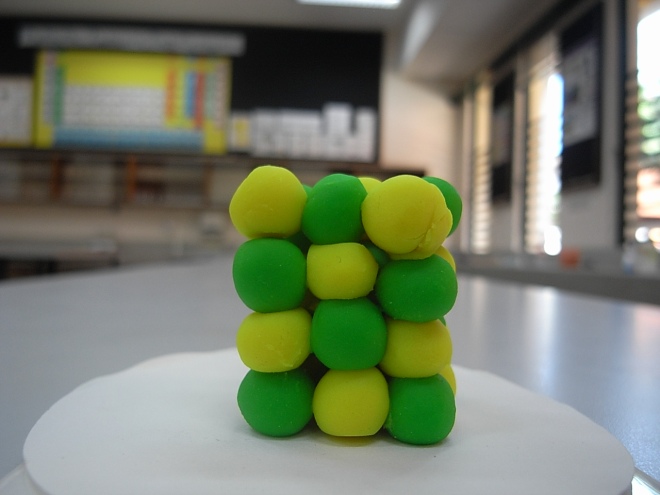Models of fir trees covered in snow are fun and easy to make.
First you need to cut out a shape from cardboard (or other porous material). It is best if this is free standing as shown below. Water soluble colour can also be applied at this stage. We used felt tipped pens.
Once the salt solution is added as described above it takes time to soak up through the cardboard. Evaporation of the water leads to stunning crystal ‘snow’ formation, especially along the edges of the shape.
The salt crystals seen here are very small and (according to the CLEAPSS sheet) due to the effect of the potassium hexacyanoferrate (II), which produces multiple nucleation points around which the crystals form.
Such small crystals are exactly the opposite of the large crystals one would need to carry out X-ray crystallography in order to determine the structure of a crystal. The cubic structure of sodium chloride is however, well known (and the ones in the snow scenes are assumed to be the same).
We made a model of the structure of sodium chloride using modelling clay.
What is 2014 the International Year of?
Here are the answers to the questions posed in the December 13th blog:
1 The gas which inflated the balloons was carbon dioxide.
2 Symbol equations for the two chemical reactions are:
NaHCO3 + HCl -> NaCl + H2O + CO2
CaCO3 + 2HCl -> CaCl2 + H2O + CO2
3 Calculations to show how much gas would be produced by 0.5g of each carbonate:
For NaHCO3
n=m/Mr
where n = number of moles in mol
m = mass in g
Mr = relative molar mass in g mol-1
n = 0.5/84 = 0.006 mol
For CaCO3
n = 0.5/100 = 0.005 mol
It can be seen from the equations that the number of moles of CO2 produced in each case is the same as the number of moles of carbonate used.
4 Since the HCl is in 6.67 to 8 times molar excess the NaHCO3 might be expected to inflate the balloon slightly faster. In the lab it was found that the result was too close to call with both balloons inflating in a matter of seconds.
Finally, at least one other source described making snow scenes using potassium hexacyanoferrate (III) instead of (II). This might be worth investigating from a safety point of view if making up a large volume of stock solution and one would need to consult the relevant MSDS sheets.








